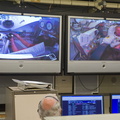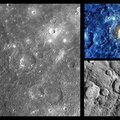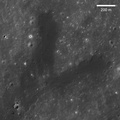
WIKIARCHIVES.SPACE
The Human Spaceflight Archive

The crater Geddes has drawn scientific attention because of its complex geological history that appears to have involved both tectonic deformation and volcanism. When the Mariner 10 mission viewed the crater in 1974-75 (image at bottom right), its low-Sun perspective emphasized topography, making the high-relief ridge Antoniadi Dorsum, which cuts through the crater, easily visible. In contrast, MESSENGER's images of Geddes crater (NAC at left; WAC at top right) emphasize color and albedo features, therefore highlighting the compositional differences on the floor of this interesting crater. The enhanced-color WAC image reveals the crater floor to have a distinctive orange hue, similar to that in areas associated with explosive volcanism in other MESSENGER enhanced-color images. The floor of Geddes also has a pit similar to those in other pit-floor craters. Such pits may have been formed by the withdrawal of subsurface magma. This crater was given its name in March 2010 in honor of Wilhelmina Geddes (1887-1955), an Irish stained glass and graphic artist.
Information
- Taken in
- Автор
- NASA/Johns Hopkins University Applied Physics Laboratory/Carnegie Institution of Washington
- Описание
-
The crater Geddes has drawn scientific attention because of its complex geological history that appears to have involved both tectonic deformation and volcanism. When the Mariner 10 mission viewed the crater in 1974-75 (image at bottom right), its low-Sun perspective emphasized topography, making the high-relief ridge Antoniadi Dorsum, which cuts through the crater, easily visible. In contrast, MESSENGER's images of Geddes crater (NAC at left; WAC at top right) emphasize color and albedo features, therefore highlighting the compositional differences on the floor of this interesting crater. The enhanced-color WAC image reveals the crater floor to have a distinctive orange hue, similar to that in areas associated with explosive volcanism in other MESSENGER enhanced-color images. The floor of Geddes also has a pit similar to those in other pit-floor craters. Such pits may have been formed by the withdrawal of subsurface magma. This crater was given its name in March 2010 in honor of Wilhelmina Geddes (1887-1955), an Irish stained glass and graphic artist.
Date Acquired: October 6, 2008
Instrument: Narrow Angle Camera (NAC) and Wide Angle Camera (WAC) of the Mercury Dual Imaging System (MDIS)
Scale: The diameter of Geddes is 80 kilometers (50 miles)
Projection: This image is a portion of the global Mercury mosaic. It is shown in a simple cylindrical map projection.
- Създаден на
- вторник 22 юни 2010
- Албуми
- US SPACE PROGRAM / PROBES / MERCURY / MESSENGER / Annoted/Science
- Source link
- https://photojournal.jpl.nasa.gov
- Посещения
- 16
- Рейтинг
- няма оценка
- Оцени тази снимка
- License
- Public Domain
- Modified by WikiArchives
- No (original)
- Сваляния
- 0
Осъществено от Piwigo











